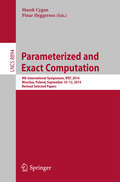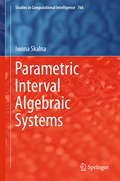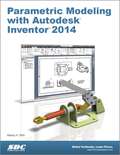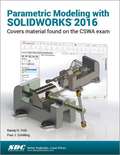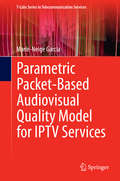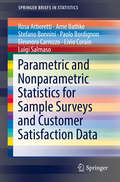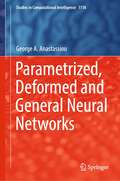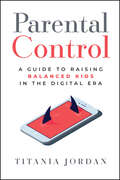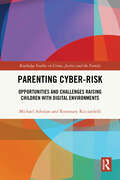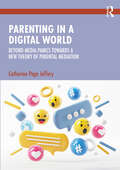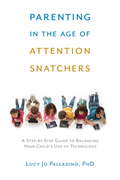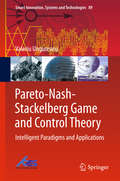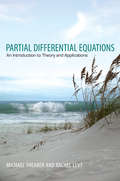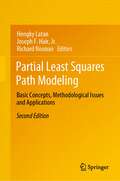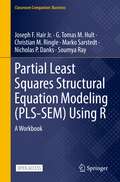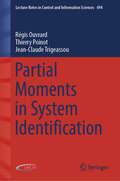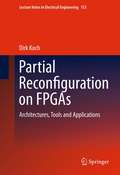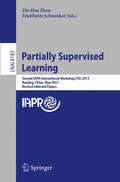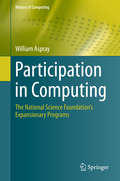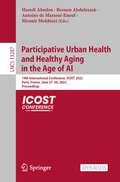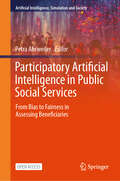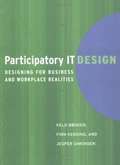- Table View
- List View
Parameterized and Exact Computation
by Marek Cygan Pinar HeggernesThis book constitutes the thoroughly refereed post-conference proceedings of the 9th International Symposium on Parameterized and Exact Computation, IPEC 2014, in Wroclaw, Poland, in September 2014. The 27 revised full papers presented together with one invited paper were carefully reviewed and selected from 42 submissions. The topics addressed cover research in all aspects of parameterized/exact algorithms and complexity including but are not limited to new techniques for the design and analysis of parameterized and exact algorithms, fixed-parameter tractability results; parameterized complexity theory, relationship between parameterized complexity and traditional complexity classifications; applications of parameterized and exact exponential-time computation; and implementation issues of parameterized and exact exponential-time algorithms.
Parametric Interval Algebraic Systems (Studies in Computational Intelligence #766)
by Iwona SkalnaThis self-contained book presents a framework for solving a general class of linear systems with coefficients being continuous functions of parameters varying within prescribed intervals. It also provides a comprehensive overview of the theory related to solving parametric interval linear systems and the basic properties of parametric interval matrices. In particular, it develops several new algorithms delivering sharp rigorous bounds for the solutions of such systems with full mathematical rigor. The framework employs the arithmetic of revised affine forms that enables the readers to handle dependent data. The book is intended not only for researchers interested in developing rigorous methods of numerical linear algebra, but also for engineers dealing with problems involving uncertain data. The theory discussed is also useful in various other fields of numerical analysis, in computer graphics, economics, computational geometry, computer-aided design, computer-assisted proofs, computer graphics, control theory, solving constraint satisfaction problems, and global optimization.
Parametric Modeling With Siemens NX
by Randy ShihThe primary goal of Parametric Modeling with Siemens NX is to introduce the aspects of designing with Solid Modeling and Parametric Modeling. This text is intended to be used as a practical training guide for students and professionals. This text uses Siemens NX as the modeling tool, and the chapters proceed in a pedagogical fashion to guide you from constructing basic solid models to building intelligent mechanical designs, creating multi-view drawings and assembly models. This text takes a hands-on, exercise-intensive approach to all the important Parametric Modeling techniques and concepts.
Parametric Modeling with Autodesk Inventor 2014
by Randy H. ShihParametric Modeling with Auto desk Inventor 2014 contains a series of sixteen tutorial style lessons designed to introduce Auto desk Inventor, solid modeling, and parametric modeling. It uses a hands-on, exercise-intensive approach to all the import parametric modeling techniques and concepts.
Parametric Modeling with SOLIDWORKS 2016
by Randy H. Shih Paul J. Schilling<p>Parametric Modeling with SOLIDWORKS 2016 contains a series of sixteen tutorial style lessons designed to introduce SOLIDWORKS 2016, solid modeling and parametric modeling techniques and concepts. This book introduces SOLIDWORKS 2016 on a step-by-step basis, starting with constructing basic shapes, all the way through to the creation of assembly drawings and motion analysis. <p>This book takes a hands on, exercise intensive approach to all the important Parametric Modeling techniques and concepts. Each lesson introduces a new set of commands and concepts, building on previous lessons. The lessons guide the user from constructing basic shapes to building intelligent solid models, assemblies and creating multi-view drawings. <p>This book also covers some of the more advanced features of SOLIDWORKS 2016, including how to use the SOLIDWORKS Design Library, basic motion analysis, collision detection and analysis with SimulationXpress. <p>The exercises in this book cover the performance tasks that are included on the Certified SOLIDWORKS Associate (CSWA) Examination. Reference guides located at the front of the book and in each chapter show where these performance tasks are covered.</p>
Parametric Packet-based Audiovisual Quality Model for IPTV services
by Marie-Neige GarciaThis volume presents a parametric, packet-based, comprehensive model to measure and predict the audiovisual quality of Internet Protocol Television services as it is likely to be perceived by the user. The comprehensive model is divided into three sub-models referred to as the audio model, the video model, and the audiovisual model. The audio and video models take as input a parametric description of the audiovisual processing path, and deliver distinct estimates for both the audio and video quality. These distinct estimates are eventually used as input data for the audiovisual model. This model provides an overall estimate of the perceived audiovisual quality in total. The parametric description can be used as diagnostic information. The quality estimates and diagnostic information can be practically applied to enhance network deployment and operations. Two applications come to mind in particular: Network planning and network service quality monitoring. The audio model can be used indifferently for both applications. However, two variants of the video model have been developed in order to address particular needs of the applications mentioned above. The comprehensive model covers effects due to resolution, coding, and IP-packet loss in case of RTP-type transport. The model applied to quality monitoring is standardized under the ITU-T Recommendations P. 1201 and P. 1201. 2.
Parametric and Nonparametric Statistics for Sample Surveys and Customer Satisfaction Data (SpringerBriefs in Statistics)
by Stefano Bonnini Livio Corain Luigi Salmaso Rosa Arboretti Eleonora Carrozzo Arne Bathke Paolo BordignonThis book deals with problems related to the evaluation of customer satisfaction in very different contexts and ways. Often satisfaction about a product or service is investigated through suitable surveys which try to capture the satisfaction about several partial aspects which characterize the perceived quality of that product or service. This book presents a series of statistical techniques adopted to analyze data from real situations where customer satisfaction surveys were performed.The aim is to give a simple guide of the variety of analysis that can be performed when analyzing data from sample surveys: starting from latent variable models to heterogeneity in satisfaction and also introducing some testing methods for comparing different customers. The book also discusses the construction of composite indicators including different benchmarks of satisfaction. Finally, some rank-based procedures for analyzing survey data are also shown.
Parametrized, Deformed and General Neural Networks (Studies in Computational Intelligence #1116)
by George A. AnastassiouIn this book, we introduce the parametrized, deformed and general activation function of neural networks. The parametrized activation function kills much less neurons than the original one. The asymmetry of the brain is best expressed by deformed activation functions. Along with a great variety of activation functions, general activation functions are also engaged. Thus, in this book, all presented is original work by the author given at a very general level to cover a maximum number of different kinds of neural networks: giving ordinary, fractional, fuzzy and stochastic approximations. It presents here univariate, fractional and multivariate approximations. Iterated sequential multi-layer approximations are also studied. The functions under approximation and neural networks are Banach space valued.
Parental Control: A Guide to Raising Balanced Kids in the Digital Era
by Titania JordanPractical strategies and tips to help raise and teach children in a digital-first world In Parental Control: A Guide to Raising Balanced Kids in the Digital Era, Titania Jordan, a renowned internet and social media safety specialist, tackles the urgent dilemmas of modern parenting head-on. As technology increasingly engulfs the lives of our children, this book emerges as a beacon for those looking to guide, protect, and connect with them in meaningful ways. Navigating the complex digital landscape, Jordan delves into the effects of social media and the internet on our kids. She uncovers the challenges of balancing screen time with real-life interactions and the erosion of offline social skills due to digital immersion. Yet, it's not all dire—Jordan's expert insights offer a pathway to turning potential digital pitfalls into educational opportunities. The book will help you: Learn how to educate and empower the next generation to navigate the internet safely and responsibly Discover actionable advice on setting boundaries, fostering offline interactions, and promoting healthy digital habits. Benefit from the latest internet safety data, trends, and tips to keep your children protected in the digital age Perfect for parents, educators, and caregivers, Parental Control is more than just a book. It's a roadmap to raising well-adjusted children in a technology-driven world. This guide provides the tools you need to ensure technology complements the lives of those you care about, rather than consuming them. If you're looking to navigate the challenges of modern-day parenting with confidence and create a safe, balanced digital environment for your children, then this book is for you.
Parenting Cyber-Risk: Opportunities and Challenges Raising Children with Digital Environments (Routledge Studies in Crime, Justice and the Family)
by Michael Adorjan Rosemary RicciardelliOn the back of their last book, Cyber-risk and Youth, and building on a new research project, Adorjan and Ricciardelli marshal current research to explore parenting in the digital age.Utilizing 70 original interviews from rural and urban area Canadian parents, the book provides an overview of research on “digital parenting” and illuminates the modern parental experience of managing children’s access to internet-connected technologies. The book explores parents’ experiences with cyberbullying and nonconsensual sexting, as well as concerns over breaches of privacy, screen time and internet addiction. It also investigates parents’ views regarding effective and ineffective strategies in mediation of technology and cyber-risk, including new directions such as restorative practices intended as a response to online conflict and harm. While framing their discussions among sociological theories, Adorjan and Ricciardelli also deliberately emphasize the gendered nature of the book’s discourses and encourage critical reflection of various online surveillance technologies, often marketed to mothers, to keep children safe.As such, Parenting Cyber-Risk is a standout research monograph which not only offers broad insight into 21st-century parenting challenges but also offers solutions. The book will be of interest to advanced undergraduate and postgraduate students studying criminology, sociology and any other related fields.
Parenting in a Digital World: Beyond Media Panics Towards a New Theory of Parental Mediation
by Catherine Page JefferyThis book focuses on the challenges of parenting in the digital age, providing a counter-narrative to, and critique of, risk and cyber safety narratives, as well as some suggestions for a way forward.Drawing on qualitative research with Australian families, this book explores the knowledges, practices, anxieties and lived experiences of families themselves. It demonstrates that the realities of family life in the digital age are more complex than the headlines and cyber safety advice would have us believe, as parents grapple with balancing their own anxieties and social expectations about what it means to be a ‘good’ parent, with the practices, desires, and rights of their child. It addresses key questions including: How much attention should we pay to media headlines about the dangers of contemporary media? What is actually worrying Australian parents and how do they address these concerns? Why do young people love media so much? How capable are young people of actually managing online risk? What is the right way to parent in the digital age to ensure young people’s safety and wellbeing while minimising family conflict?Aimed at media studies scholars and students, as well as parents and policy makers seeking a more comprehensive understanding of the broader academic research surrounding young people, media and parenting, this book argues that parent and child knowledges, practices and experiences must be better accounted for within the online safety ecosystem as well as in policy development, and that families need encouragement and guidance to help them adopt more democratic approaches to parenting in the digital age.
Parenting in the Age of Attention Snatchers: A Step-by-Step Guide to Balancing Child's Use of Technology
by Lucy Jo PalladinoAre your kids glued to their screens? Here is a practical, step-by-step guide that gives parents the tools to teach children, from toddlers to teens, how to gain control of their technology use. As children spend more of their time on tablets and smartphones, using apps specially engineered to capture their attention, parents are becoming concerned about the effects of so much technology use--and they feel powerless to intervene. They want their kids to be competent and competitive in their use of technology, but they also want to prevent the attention and behavioral problems that can develop from overuse.In this guide, Lucy Jo Palladino doesn't demonize technology; instead she gives parents the tools to help children understand and control their attention--and to recognize and resist when their attention is being "snatched." Palladino's straightforward, evidence-based approach applies to kids of all ages. Parents will also learn the critical difference between voluntary and involuntary attention, new findings about brain development, and what puts children at risk for attention disorders.
Pareto-Nash-Stackelberg Game and Control Theory: Intelligent Paradigms And Applications (Smart Innovation, Systems And Technologies #89)
by Valeriu UngureanuThis book presents a comprehensive new, multi-objective and integrative view on traditional game and control theories. Consisting of 15 chapters, it is divided into three parts covering noncooperative games; mixtures of simultaneous and sequential multi-objective games; and multi-agent control of Pareto-Nash-Stackelberg-type games respectively. Can multicriteria optimization, game theory and optimal control be integrated into a unique theory? Are there mathematical models and solution concepts that could constitute the basis of a new paradigm? Is there a common approach and method to solve emerging problems? The book addresses these and other related questions and problems to create the foundation for the Pareto-Nash-Stackelberg Game and Control Theory. It considers a series of simultaneous/Nash and sequential/Stackelberg games, single-criterion and multicriteria/Pareto games, combining Nash and Stackelberg game concepts and Pareto optimization, as well as a range of notions related to system control. In addition, it considers the problems of finding and representing the entire set of solutions. Intended for researches, professors, specialists, and students in the areas of game theory, operational research, applied mathematics, economics, computer science and engineering, it also serves as a textbook for various courses in these fields.
Partial Differential Equation Methods for Image Inpainting
by Carola-Bibiane SchönliebThis book is concerned with digital image processing techniques that use partial differential equations (PDE) for the task of image 'inpainting,' an artistic term for virtual image restoration or interpolation, whereby missing or occluded parts in images are completed based on information provided by intact parts. Computer graphic designers, artists and photographers have long used manual inpainting to restore damaged paintings or manipulate photographs. Today, mathematicians apply powerful methods based on PDE to automate this task. This book introduces the mathematical concept of PDE for virtual image restoration. It gives the full picture, from the first modelling steps originating in Gestalt theory and arts restoration to the analysis of resulting PDE models, numerical realisation and real world application. This broad approach also gives insight into functional analysis, variational calculus, optimisation and numerical analysis and will appeal to researchers and graduate students in mathematics with an interest in image processing and mathematical analysis.
Partial Differential Equations
by Michael Shearer Rachel LevyThis textbook provides beginning graduate students and advanced undergraduates with an accessible introduction to the rich subject of partial differential equations (PDEs). It presents a rigorous and clear explanation of the more elementary theoretical aspects of PDEs, while also drawing connections to deeper analysis and applications. The book serves as a needed bridge between basic undergraduate texts and more advanced books that require a significant background in functional analysis.Topics include first order equations and the method of characteristics, second order linear equations, wave and heat equations, Laplace and Poisson equations, and separation of variables. The book also covers fundamental solutions, Green's functions and distributions, beginning functional analysis applied to elliptic PDEs, traveling wave solutions of selected parabolic PDEs, and scalar conservation laws and systems of hyperbolic PDEs.Provides an accessible yet rigorous introduction to partial differential equationsDraws connections to advanced topics in analysisCovers applications to continuum mechanicsAn electronic solutions manual is available only to professorsAn online illustration package is available to professors
Partial Differential Equations for Geometric Design
by Hassan UgailThe subject of Partial Differential Equations (PDEs) which first emerged in the 18th century holds an exciting and special position in the applications relating to the mathematical modelling of physical phenomena. The subject of PDEs has been developed by major names in Applied Mathematics such as Euler, Legendre, Laplace and Fourier and has applications to each and every physical phenomenon known to us e.g. fluid flow, elasticity, electricity and magnetism, weather forecasting and financial modelling. This book introduces the recent developments of PDEs in the field of Geometric Design particularly for computer based design and analysis involving the geometry of physical objects. Starting from the basic theory through to the discussion of practical applications the book describes how PDEs can be used in the area of Computer Aided Design and Simulation Based Design. Extensive examples with real life applications of PDEs in the area of Geometric Design are discussed in the book.
Partial Least Squares Path Modeling: Basic Concepts, Methodological Issues and Applications
by Hengky Latan Richard Noonan Joseph F. Hair Jr.Now in its second edition, this edited book presents recent progress and techniques in partial least squares path modeling (PLS-PM), and provides a comprehensive overview of the current state-of-the-art in PLS-PM research. Like the previous edition, the book is divided into three parts: the first part emphasizes the basic concepts and extensions of the PLS-PM method; the second part discusses the methodological issues that have been the focus of recent developments, and the last part deals with real-world applications of the PLS-PM method in various disciplines.This new edition broadens the scope of the first edition and consists of entirely new original contributions, again written by expert authors in the field, on a wide range of topics, including: how to perform quantile composite path modeling with R; the rationale and justification for using PLS-PM in top-tier journals; psychometric properties of three weighting schemes and why PLS-PM is a better fit to mode B; a comprehensive review of PLS software; how to perform out-of-sample predictions with ordinal consistent partial least squares; multicollinearity issues in PLS-PM using ridge regression; theorizing and testing specific indirect effects in PLS and considering their effect size; how to run hierarchical models and available approaches; and how to apply necessary condition analysis (NCA) in PLS-PM.This book will appeal to researchers interested in the latest advances in PLS-PM as well as masters and Ph.D. students in a variety of disciplines who use PLS-PM methods. With clear guidelines on selecting and using PLS-PM, especially those related to composite models, readers will be brought up to date on recent debates in the field.
Partial Least Squares Structural Equation Modeling: A Workbook (Classroom Companion: Business)
by G. Tomas Hult Marko Sarstedt Christian M. Ringle Joseph F. Hair Jr. Nicholas P. Danks Soumya RayPartial least squares structural equation modeling (PLS-SEM) has become a standard approach for analyzing complex inter-relationships between observed and latent variables. Researchers appreciate the many advantages of PLS-SEM such as the possibility to estimate very complex models and the method’s flexibility in terms of data requirements and measurement specification. This practical open access guide provides a step-by-step treatment of the major choices in analyzing PLS path models using R, a free software environment for statistical computing, which runs on Windows, macOS, and UNIX computer platforms. Adopting the R software’s SEMinR package, which brings a friendly syntax to creating and estimating structural equation models, each chapter offers a concise overview of relevant topics and metrics, followed by an in-depth description of a case study. Simple instructions give readers the “how-tos” of using SEMinR to obtain solutions and document their results. Rules of thumb in every chapter provide guidance on best practices in the application and interpretation of PLS-SEM.
Partial Moments in System Identification (Lecture Notes in Control and Information Sciences #494)
by Jean-Claude Trigeassou Régis Ouvrard Thierry PoinotThis book provides a complete round-up of developments concerned with the application of partial moments in system identification and data-driven modelling; it captures the essence of work carried out at the Laboratoire d'Informatique et d'Automatique pour les Systèmes for more than 40 years. The book begins with introductory material, describing both the mathematical tools associated with partial moments and reinitialized partial moments and an example demonstrating their use. The authors then proceed to show how these tools can be used for the identification of continuous-time linear models, discrete-time linear models, continuous-time linear state-space models, linear parameter-varying models and multidimensional models based on partial differential equations. The properties and performances of each of these approaches are presented. The analogy with algebraic approaches is proved, thus opening perspectives for extension to other fields. The text removes some long-standing limitations on the implementation of partial-moment-based tools in system identification. This book is of interest to researchers and postgraduates studying system identification, control theory, applied mathematics and computer science. It is also useful for engineers working on industrial applications of the parametric estimation of mathematical models.
Partial Reconfiguration on FPGAs
by Dirk KochThis is the first book to focus on designing run-time reconfigurable systems on FPGAs, in order to gain resource and power efficiency, as well as to improve speed. Case studies in partial reconfiguration guide readers through the FPGA jungle, straight toward a working system. The discussion of partial reconfiguration is comprehensive and practical, with models introduced together with methods to implement efficiently the corresponding systems. Coverage includes concepts for partial module integration and corresponding communication architectures, floorplanning of the on-FPGA resources, physical implementation aspects starting from constraining primitive placement and routing all the way down to the bitstream required to configure the FPGA, and verification of reconfigurable systems.
Partially Supervised Learning
by Zhi-Hua Zhou Friedhelm SchwenkerThis book constitutes the thoroughly refereed revised selected papers from the Second IAPR International Workshop, PSL 2013, held in Nanjing, China, in May 2013. The 10 papers included in this volume were carefully reviewed and selected from 26 submissions. Partially supervised learning is a rapidly evolving area of machine learning. It generalizes many kinds of learning paradigms including supervised and unsupervised learning, semi-supervised learning for classification and regression, transductive learning, semi-supervised clustering, multi-instance learning, weak label learning, policy learning in partially observable environments, etc.
Participation in Computing
by William AsprayThis book provides a history of the efforts of the US National Science Foundation to broaden participation in computing. The book briefly discusses the early history of the NSF's involvement with education and workforce issues. It then turns to two programs outside the computing directorate (the ADVANCE program and the Program on Women and Girls) that set the stage for three programs in the NSF computing directorate on broadening participation: the IT Workforce Program, the Broadening Participation in Computing program, and the Computing Education for the 21st Century program. The work looks at NSF-funded research and NSF-funded interventions both to increase the number of women, underrepresented minorities (African Americans, Hispanics, and American Indians) and people with disabilities, and to increase the number of public schools offering rigorous instruction in computing. Other organizations such as the ACM, the Computer Science Teachers Association, and Code. org are also covered. The years covered are primarily 1980 to the present.
Participative Urban Health and Healthy Aging in the Age of AI: 19th International Conference, ICOST 2022, Paris, France, June 27–30, 2022, Proceedings (Lecture Notes in Computer Science #13287)
by Mounir Mokhtari Hamdi Aloulou Bessam Abdulrazak Antoine de Marassé-EnoufThis open access book constitutes the refereed proceedings of the 18th International Conference on String Processing and Information Retrieval, ICOST 2022, held in Paris, France, in June 2022.The 15 full papers and 10 short papers presented in this volume were carefully reviewed and selected from 33 submissions. They cover topics such as design, development, deployment, and evaluation of AI for health, smart urban environments, assistive technologies, chronic disease management, and coaching and health telematics systems.
Participatory Artificial Intelligence in Public Social Services: From Bias to Fairness in Assessing Beneficiaries (Artificial Intelligence, Simulation and Society)
by Petra AhrweilerThis open access edited volume focuses on fairness issues concerning the use of artificial intelligence (AI) for social service provision in national welfare systems. With this, it touches upon important questions in the innovation agenda of countries across continents about the ethics, justice, quality, responsibility, accountability, and transparency to use AI for state functions. The volume shows that in many countries, AI, or at least data analytics methods, are already in place to support the assessment of beneficiaries for deciding on the value criteria to distinguish between legal /fraudulent, deserving/non-deserving, or needy/non-needy recipients. The book provides a cross-cultural comparison of AI-based social assessment among national welfare systems of 9 countries across 4 continents: Spain, Estonia, Germany, Iran, India, Nigeria, Ukraine, China and USA. Based on participatory research results from multi-stakeholder inputs, especially those from vulnerable groups, the chapters in this volume show that value criteria for fairness and social justice are context-bound and vary across the globe. Furthermore, they are in constant flux, aligned to social change. Thus, the volume looks at pathways to developing culture-sensitive, responsive and participatory AI for social assessment in public service provision. The contributions are interdisciplinary and introduce perspectives from the fields of sociology, computational social science, computer science and public policy. This topical volume is of interest to a wide readership.
Participatory IT Design: Designing for Business and Workplace Realities
by Keld Bodker Finn Kensing Jesper SimonsenThe goal of participatory IT design is to set sensible, general, and workable guidelines for the introduction of new information technology systems into an organization. Reflecting the latest systems-development research, this book encourages a business- oriented and socially sensitive approach that takes into consideration the specific organizational context as well as first-hand knowledge of users' work practices and allows all stakeholders--users, management, and staff--to participate in the process. Participatory IT Designis a guide to the theory and practice of this process that can be used as a reference work by IT professionals and as a textbook for classes in information technology at introductory through advanced levels. Drawing on the work of a ten-year research program in which the authors worked with Danish and American companies, the book offers a framework for carrying out IT design projects as well as case studies that stand as examples of the process. The method presented in Participatory IT Design--known as the MUST method, after a Danish acronym for theories and methods of initial analysis and design activities--was developed and tested in thirteen industrial design projects for companies and organizations that included an American airline, a multinational pharmaceutical company, a national broadcasting corporation, a multinational software house, and American and Danish universities. The first part of the book introduces the concepts and guidelines on which the method is based, while the second and third parts are designed as a practical toolbox for utilizing the MUST method. Part II describes the four phases of a design project--initiation, in-line analysis, in-depth analysis, and innovation. Part III explains the method's sixteen techniques and related representation tools, offering first an overview and then specific descriptions of each in separate sections.
